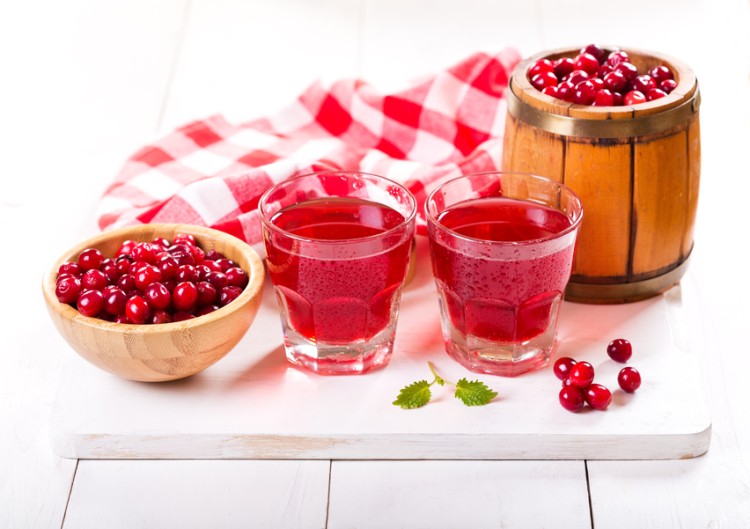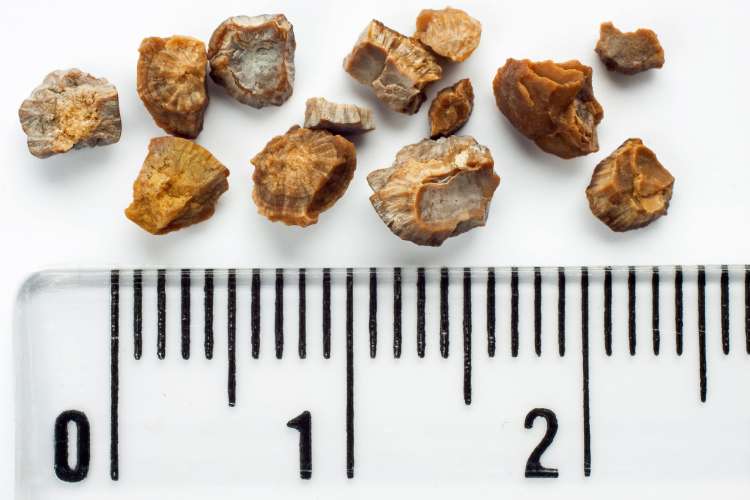Is Drinking Cranberry Juice For Kidney Stones Any Good?
People have been drinking cranberry juice as a natural remedy for urinary tract infections for ages. But what about kidney stones? Does drinking cranberry juice for kidney stones have any real benefits or does cranberry juice increase the risk of kidney stone formation? Here is a detailed, evidence-based article on the real benefits and drawbacks of cranberry juice in management and prevention of kidney stones.
What are cranberries?
Cranberries are a fruit growing on bushes or vines of the Vaccinium genus (Vaccinium oxycoccos in UK and Vaccinium macrocarpon in North America) (1).
Cranberries are closely related to other berries, such as blueberries, lingo-berries or bilberries.
They mainly consist of water (nearly 90%) and are high in fiber (4.6 g per 100 g of raw cranberries) and carbs (12.2 g per 100 g) (2).
Cranberries also contain several essential vitamins and minerals.
They are exceptionally high in vitamins C, E and K1, as well as in manganese and copper.
Cranberries are loaded with antioxidants, such as flavonols and polyphenols (3, 4).
Various bioactive plant compounds found in cranberries, such as A-type proanthocyanidins, make them an excellent food for prevention of urinary tract infections (5, 6, 7).
The leading cause of urinary tract infections is Escherichia coli bacteria, which live in your intestines.
When you poop, E.coli may attach to your bladder and urinary tract lining, which causes a urinary tract infection.
A-type proanthocyanidins or condensed tannins may prevent Escherichia coli from attaching to your urinary tract lining.

Cranberry juice increases your risk of developing a kidney stone but may have positive effects on UTIs
Studies suggest that drinking cranberry juice or taking cranberry supplements may decrease the risk of urinary tract infections (8, 9, 10, 11, 12).
However, other studies do not confirm any real benefits of drinking cranberry juice for UTI prevention or treatment (13, 14).
What is more, studies have found that processing decreases the amounts of A-type proanthocyanidins in cranberry products and cranberry juices may not contain any proanthocyanidins at all (15).
In addition to urinary tract infection, cranberries may also be beneficial for your heart, thanks to their LDL cholesterol and blood pressure lowering properties (16, 17).
What are kidney stones?
According to experts, one in every ten people will develop a kidney stone during their lifetime (18).
So it is a widespread medical problem.
As the name suggests, kidney stones are hard lumps that form inside your kidneys or other parts of your urinary tract.
In general, there are four types of kidney stones, depending on minerals and salts they contain (19, 20).
The most common type of kidney stones is calcium stones.
These consist of calcium oxalate, phosphate or maleate. If you want to decrease your risk of getting a calcium kidney stone, eat less oxalate-rich foods, such as potato chips, beets, spinach or chocolate and drink less oxalate-rich drinks, such as cranberry juice.
If you eat lots of meat or other foods rich in purines (a substance found in animal proteins), such as fish or shellfish, you may develop a uric acid kidney stone. This type of kidney stone frequently occurs in people with gout or post chemotherapy.
Struvite kidney stones mostly occur in women with recurring urinary tract infections. As the primary cause of struvite stones is a urinary tract infection, your best prevention is a proper treatment of the underlying disease.
People with cystinuria (a genetic disorder) may develop cystine kidney stones. Cystine is an acid, which is usually absorbed in kidneys. If you have cystinuria, some cystine (oxidized form of the cysteine amino acid) leaks into your urine, which results in the development of cystine stones.
When kidney stones block your urinal tract or kidneys, you may feel a very sharp pain in your side and back. Also, urination may be painful, and your urine may become cloudy, smelly or pink to brown. Nausea, vomiting and persistent need to urinate are other common symptoms of kidney stones.
If you have any of the symptoms above, see your doctor as soon as possible.

This is how kidney stones look like
As far as the treatment of kidney stones is concerned, it depends on the size and type of your stone (21).
It also depends on whether your stone causes issues (such as pain, problems urinating, blood in urine, etc.) or not.
It is usually possible to pass a smaller stone by drinking enough fluids (plain still water is the best). You may also be given some pain relievers and other medication (alpha blockers, muscle relaxants, thiazide diuretics, etc.) to help you pass the stone.
If your stone is too big or causes you trouble, various other treatment options are available, including lithotripsy (the name of the procedure is ESWL - Extracorporeal Shock Wave Lithotripsy), surgery (e.g., percutaneous nephrolithotomy), ureteroscopy or parathyroid gland surgery.
Your doctor will also ask you to follow a kidney friendly diet (eat less oxalate-rich foods, drink enough fluids, etc.) to prevent re-occurrence of kidney stones.
Is drinking cranberry juice good for kidney stones?
As you already know, the majority of kidney stones are made of calcium oxalate.
The primary risk factor for developing a kidney stone is the excessive amount of oxalate in urine (22).
Cranberry juice (as well as other cranberry based products, such as extracts or supplements) are a rich source of oxalate, and if you drink high volumes of it, you may increase your risk of developing a kidney stone (23, 24).
What is more, cranberry juice is rich in vitamin C.
The structure of this vitamin is similar to oxalates, and studies suggest that in some people, vitamin C may be transformed to oxalates, which further increases its amount in urine (25).
However, not all studies agree, so additional research is necessary to confirm the benefits and risks of cranberry juice or supplements for kidney stones (26, 27).
To sum up, you should not drink cranberry juice or take cranberry supplements if you already have a kidney stone or are at a higher risk of developing one.
Do not expect cranberry juice to help you pass the stone. It is much better to drink plenty of water instead of cranberry juice if you are trying to get rid of your kidney stone.
If you do not have kidney stones, you may drink cranberry juice in moderation (a small glass of cranberry per week will do no harm but do not drink gallons of it).
What is the best drink to prevent or pass kidney stones?
While cranberry juice is bad for kidney stones, drinking plenty of fluids may help you pass or prevent kidney stones (28).
So what should you drink?
The answer is plain water.
To pass a kidney stone, you should follow the instructions given by your doctor. Usually, your doctor will tell you to drink enough water to make your urine nearly colorless.
Another great drink, which may help you prevent kidney stone development, is lemon juice.
It contains citrate (citric acid), which prevents kidney stones by binding calcium oxalate crystals and limiting their growth (29).
Studies suggest that consuming just 4 oz (about 118 ml) of lemon juice a day significantly reduces the risk of calcium oxalate stone development (30).
Alternatively, you can drink melon or orange juice, which are also rich in citrate (31).
Other dietary measures to prevent development of kidney stones
In addition to hydration and citric acid, you should also reduce the consumption of oxalate rich foods, such as potatoes, nuts or spinach.
On the other hand, you should eat plenty of foods containing calcium (target daily intake should be about 1200 mg, which translates to 4 glasses (8-oz or 236 ml each) of milk. Surprisingly low calcium intake increases the risk of calcium oxalate stone development as calcium binds oxalate in your gastrointestinal tract (GIT) and prevents it from being absorbed and excreted in urine.
This lowers the risk of calcium oxalate stone development.
Besides milk, other excellent dietary sources of calcium include tofu, sardines with bones and almonds.
Do not take excessive doses of vitamin C as it is transformed to oxalate and may increase the risk of kidney stone development.
Fish oil is rich in omega-3 acids (mainly EPA - eicosapentaenoic acid), which can also be helpful in the prevention of kidney stones.
Studies show that daily consumption of 1,200 mg fish oil significantly reduces the risk of developing a calcium oxalate kidney stone by increasing citrate concentration and decreasing urinary calcium and oxalate levels (32).
Excellent sources of EPA are fish, walnuts or flax seeds.
The takeaway
While cranberry juice may be helpful in the treatment of urinary tract infections, it is bad for kidney stones.
It is high in oxalates, which increases the risk of developing calcium oxalate kidney stones.
The best drinks for kidney stones include plain water and juices rich in citric acid (such as lemon, orange or melon juice).
In any case, if you think you may have a kidney stone, see your doctor as soon as possible.
Your physician will examine you, diagnose the problem and recommend dietary and medical measures to manage the kidney stones.
| Written by: | Michal Vilímovský (EN) |
|---|---|
| Education: | Physician |
| Article resources: | This is an evidence-based post. Peer reviewed studies are referenced as numbered links in the article. |
| Image resources: | Stockphotosecrets.com |
| Published: | August 18, 2017 at 12:00 AM |
| Next scheduled update: | August 18, 2019 at 12:00 AM |
Get more articles like this in your inbox
Sign up for our daily mail and get the best evidence based health, nutrition and beauty articles on the web.


Ache in left arm that you should not ignore
Alkaline water dangers: why you should not drink it
How to Avoid Sleepiness While Studying?
23 Foods That Increase Leptin Sensitivity
Low dopamine (e.g. dopamine deficiency): causes, symptoms, diagnosis and treatment options
Swollen taste buds: the ultimate guide to causes, symptoms and treatment
Thin endometrial lining: causes, symptoms, diagnosis and treatment
Pimples inside nose: the complete guide
Holes in tonsils: definition, symptoms, treatment and prevention
How to deal with an ingrown hair cyst
Allegra vs. Zyrtec vs. Claritin
Allergy to penicillin and alternative antibiotics
How to get rid of phlegm (excessive mucus) in throat? Detailed guide to medical and home remedies, symptoms and causes
What causes stomach ache after meals?
Liver blood test results explained